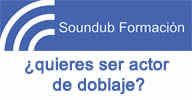EduRobayna escribió:
Alfred Hitchcock dijo una vez: “Con el doblaje se pierde un 40% de la película, pero con los subtítulos un 60%. Por lo tanto, el doblaje es un mal menor”.
Yo creo que para quien sepa inglés perfecto y pueda ver la película/serie sin necesidad de leer, adelante con la V.O. Pero claro, no todo el cine y TV es en inglés ni toda la población lo habla nivel nativo. Hay muchos más idiomas más y no los dominamos todos. Además, yo soy de los que piensa que se pierde mucho leyendo, y de los que cuando quiero ver algo, me gusta relajarme y a veces tener que leer tan rápido, me estresa.
Y también observo que muchas veces los subtítulos -los oficiales, porque los otros dejan que desear muchas veces, aunque se agradece la intención- cambian el diálogo, se comen palabras, tienen faltas de ortografías, se lo saltan o está mal. Vamos, como puede pasar con un doblaje, pero aquí nunca hay críticas.
No recuerdo quién me lo dijo o dónde lo escuché, pero tenía razón: una versión subtitulada tampoco es del todo original, porque también se traduce un idioma y el lenguaje se interpreta muchas veces.
PD: no sé si alguno ha visto en Netflix "El abuelo que no pagó la cuenta y se marchó". Tiene la peculiaridad de que solo doblan la mitad de la película. La otra mitad, en V.O. El sueco sí lo doblan, pero, si no me equivoco, el inglés, el alemán y el ruso, no. Y me gustaba esta idea. El de no doblar todo cuando hay muchos idiomas a la vez. Pero claro, me parecería bien si pusieran subtítulos... ¡pero no los ponen! Para enterarte de algo tienes que activar de manera manual los subtítulos para toda la cinta, parte doblada incluida. Que por cierto, segundo disparate: cada uno decía una cosa. No sé quién sería el culpable de traducirla a su manera, si la persona encargada de los subtítulos o el traductor del doblaje, pero era un poco de risa.
Eso es todo, jaja. Esperemos tener hoy noticias buenas

Alfred Hitchcock once said with dubbing 40% of the film is lost 40%, but with the subtitles 60%. Therefore, dubbing is a lesser evil. "
I think that for those who know perfect English and can see the film / series without reading, go with the V.O. But of course, not all cinema and TV is in English nor does the whole population speak native level. There are many more languages and we do not dominate them all.Besides, I am one of those who thinks that much is lost reading, and when I want to see something, I like to relax and sometimes to have to read so fast, it stresses me.
And I also notice that many times the subtitles - the official ones, because the others leave to wish many times, although the intention is grateful - they change the dialogue, they eat words, they misspellings, they skip or it is wrong.Come on, as can happen with a dub, but here there are never criticisms.
I do not remember who told me or where I heard it, but he was right: a subtitled version is not entirely original, because it also translates a language and the language is interpreted many times.
PS: I do not know if anyone has seen on Netflix "The grandfather who did not pay the bill and left."Has the peculiarity of only doubling half the film. The other half, in V.O. The Swedish does double it, but, if I am not mistaken, English, German and Russian, no. And I liked this idea. Not to bend everything when there are many languages at a time. But of course, it would look good if they put subtitles ...But do not put them! To find out something you have to manually activate the subtitles for the entire tape, part folded included. That by the way, second nonsense: everyone said one thing. I do not know who would be guilty of translating it in his own way, whether the person in charge of the subtitles or the translator of the dubbing, but it was a bit of a laugh.
That's it, haha.Hopefully have good news today
Hay otras maneras de aprender inglés, o al menos de entenderlo, más hoy en día

Segundos en traducirlo y en escucharlo. Saludos.









